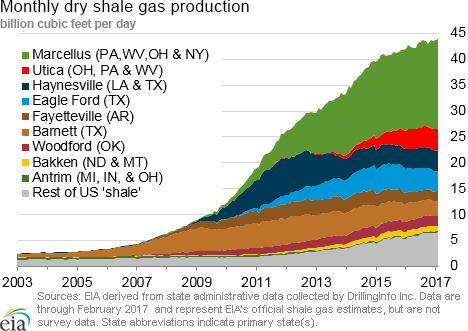In the News:
Natural gas spot prices rise with forecasts of colder temperatures along the eastern seaboard
Natural gas spot prices increased last Thursday and Friday as weather forecasts called for below-average temperatures throughout the eastern United States. The largest spot price increases occurred in New England, where the Algonquin Citygate (Boston) price rose to $7.92 per million British thermal unit (MMBtu) on Friday, March 10, its highest level since January 6. In addition, on Friday, March 10, the National Weather Service (NWS) forecasted a significant late-winter storm off the Mid-Atlantic coast to occur on March 13–14, accompanied by much lower-than-normal temperatures for the region that would persist through March 16. The Henry Hub spot price also increased 30¢ in trading Friday, compared to Monday, March 6, closing at $2.98/MMBtu.
As weather forecasts called for colder weather across a larger region of the eastern United States, spot prices increased across most hubs in these markets. In addition to the price increases in Boston, natural gas in New York (Transcontinental Pipeline Zone 6) closed on Friday at $5.93/MMBtu—a more than 150% increase over the closing price on March 6. Natural gas in the Mid-Atlantic (Texas Eastern M-3, Delivery), which has traded at a discount to Henry Hub for much of the past year, rose more than 75% from Monday’s price to close at $4.04/MMBtu on Friday.
Historically, both the Boston and New York natural gas markets have experienced winter price spikes because of pipeline constraints during periods of peak demand. Natural gas pipeline expansion projects that were completed in recent years may have reduced, but did not eliminate, sharp price increases with anticipated cold weather. Several expansion projects to the New York market came online between 2013 and 2015, which added 3.5 billion cubic feet per day (Bcf/d) of delivered capacity. In November 2016, the Algonquin Incremental Market (AIM) expansion was completed, which provided an additional 0.342 Bcf/d of natural gas deliverability and was the first increase in pipeline capacity into New England since 2010.
In recent years, natural gas has shown less winter price volatility in Northeastern markets, which is consistent with the milder winters. During the winter of 2013–2014, natural gas prices in New England reached historic highs, peaking near $80.00/MMBtu in Boston, because of prolonged, bitterly cold weather. Spot prices peaked at lower levels during the winter of 2014–15, with prices reaching $29.99/MMBtu in Boston and $38.15/MMBtu in New York despite brief record levels of natural gas consumption in February 2015. Last winter, neither market experienced spot prices that were more than $9.00/MMBtu because of record high natural gas inventories and warm weather.
Overview:
(For the Week Ending Wednesday, March 15, 2017)
- Natural gas spot prices rose at most locations this report week (Wednesday, March 8 to Wednesday, March 15). The Henry Hub spot price rose from $2.69/MMBtu last Wednesday to $3.00/MMBtu yesterday.
- At the New York Mercantile Exchange (Nymex), the April 2017 contract price rose 8¢ from $2.901/MMBtu last Wednesday to $2.981/MMBtu yesterday.
- Net withdrawals from working gas totaled 53 Bcf for the week ending March 10. Working natural gas stocks are 2,242 Bcf, which is 10% less than the year-ago level and 21% greater than the five-year (2012–16) average for this week.
- The average natural gas plant liquids composite price at Mont Belvieu, Texas, fell by 11¢, averaging $6.12/MMBtu for the week ending March 10. The price of natural gasoline, butane, and isobutane fell by 4%, 6%, and 3%, respectively. The price of ethane rose by 2%, while the price of propane remained flat week over week.
- According to Baker Hughes, for the week ending Friday, March 10, the natural gas rig count increased by 5 to 151. The number of oil-directed rigs rose by 8 to 617. The number of miscellaneous rigs went down by 1 during the week. The total rig count increased by 12, and it now stands at 768.
Prices/Supply/Demand:
Prices rise at most locations. This report week (Wednesday, March 8 to Wednesday, March 15), the Henry Hub spot price rose 31¢ from $2.69/MMBtu last Wednesday to $3.00/MMBtu yesterday. At the Chicago Citygate, prices increased 13¢ from $2.80/MMBtu last Wednesday to $2.93/MMBtu yesterday. Prices in California were flatter than in areas of the country affected by unseasonably cold temperatures and a late-winter snowstorm. At PG&E Citygate in Northern California, prices remained level week over week at $3.15/MMBtu. The price at SoCal Citygate rose 3¢ from $2.90/MMBtu last Wednesday to $2.93/MMBtu yesterday, after closing at an intraweek low of $2.65/MMBtu on Friday.
Northeast prices respond to colder-than-normal temperatures. At the Algonquin Citygate, prices increased $4.47 from $2.98/MMBtu last Wednesday to $7.45/MMBtu yesterday. Algonquin prices closed at $8.06/MMBtu on Monday, as the Northeast readied for a late-winter snowstorm (see above) and unseasonably cold weather. Transcontinental Pipeline Zone 6 prices also saw a multi-dollar increase from Thursday to Monday, although the price peaked yesterday at $6.82/MMBtu, up $4.32 from $2.50/MMBtu last Wednesday.
Also in response to the weather, Tennessee Zone 4 Marcellus spot prices advanced 52¢ from $2.25/MMBtu last Wednesday to $2.77/MMBtu yesterday. Prices at Dominion South in northwest Pennsylvania rose 47¢ from $2.38/MMBtu last Wednesday to $2.85/MMBtu yesterday.
April Nymex contract up slightly. At the Nymex, the price of the April 2017 contract increased 8¢, from $2.901/MMBtu last Wednesday to $2.981/MMBtu yesterday. The contract closed above $3.00/MMBtu on Friday, the first time the front-month contract has done so since February 10. The price of the 12-month strip averaging April 2017 through March 2018 futures contracts climbed 2¢ to $3.209/MMBtu.
Supply rises. According to data from PointLogic, the average total supply of natural gas rose by 1% compared with the previous week. Dry natural gas production remained constant week over week. Average net imports from Canada increased by 15% from last week.
Demand rises significantly. U.S. consumption of natural gas rose by 15% compared with the previous report week, according to data from PointLogic. Power burn climbed by 12% week over week, while industrial sector consumption increased by 4%. In the residential and commercial sectors, consumption increased by 24%, as cold weather and a winter snowstorm affected heating requirements in the Northeast. Natural gas exports to Mexico were the same as last week, averaging 3.9 Bcf/d.
U.S. liquefied natural gas (LNG) exports. Natural gas pipeline deliveries to the Sabine Pass liquefaction terminal averaged 2.0 Bcf/d for the report week, 73% higher than in the previous week. In the beginning of March (March 1–9), the flows to the terminal averaged 1.2 Bcf/d, 40% lower than the February average of 2.0 Bcf/d because of routine commissioning-related work for Train 3 to enhance the train’s operational performance. Three vessels (combined LNG-carrying capacity of 10.5 Bcf) departed Sabine Pass last week.
Storage:
Unseasonably mild temperatures continued during the storage week ending March 10, resulting in below-normal withdrawals from working gas storage. Net withdrawals from storage totaled 53 Bcf, compared with the five-year (2012–16) average net withdrawal of 85 Bcf and last year's net withdrawal of 9 Bcf during the same week. Mild temperatures throughout the week for most of the Lower 48 states contributed to decreased heating demand for natural gas compared with normal levels and lower withdrawals from storage. Working gas stocks total 2,242 Bcf, which is 395 Bcf more than the five-year average and 236 Bcf less than last year at this time.
Only the East region posted larger-than-average withdrawals. At 36 Bcf, net withdrawals in the East region topped the five-year average by 8 Bcf. These larger-than-average withdrawals may be attributed to increased heating demand in the New England region, which was one of the two regions with colder-than-normal temperatures during the week. In contrast, withdrawals were 8 Bcf below the five-year average of 30 Bcf in the Midwest region, which had significantly warmer-than-normal temperatures.
Working gas levels continue to increase relative to the five-year average. Working gas stocks increased compared with the five-year average for the seventh time in the past eight weeks. All regions in the Lower 48 states, except for the Pacific region, are now above their five-year average. In the South Central region, the surplus relative to the five-year average totaled 152 Bcf at salt facilities, and 106 Bcf at nonsalt facilities. Just last month, the deficit at nonsalt facilities totaled 11 Bcf. The Midwest region has a surplus of 146 Bcf. The Pacific region is 22 Bcf below the five-year average. However, the deficits in this region have declined in recent weeks.
Working gas stocks on pace to end the 2016–17 heating season close to 2,200 Bcf. If working gas stock changes follow the five-year average for the remainder of the heating season, they will total 2,181 Bcf on March 31. So far in 2017, net withdrawals are 28% below the five-year average. Following this slower-than-normal pace, working gas stocks would total 2,201 Bcf by the end of the heating season, which would mark the third time since 2011 that working gas stocks ended the heating season above 2,200 Bcf. Working gas levels topped this threshold at the end of the heating season only two other times, in 2012 and 2016, when working gas totaled 2,473 Bcf and 2,470 Bcf, respectively. Both of those heating seasons were also characterized by warmer-than-normal temperatures and relatively light heating demand for natural gas.
Withdrawals are close to market expectations for the week. According to the Bloomberg survey of natural gas analysts, estimates of net withdrawals from natural gas storage ranged from 51 Bcf to 70 Bcf, with a median withdrawal of 56 Bcf. The price of the Nymex futures contract for April 2017 delivery at Henry Hub decreased 2¢/MMBtu to $2.90/MMBtu in 329 trades at the release of the Weekly Natural Gas Storage Report (WNGSR). Prices varied and rebounded in subsequent trading, reaching $2.94/MMBtu within two hours of the WNGSR release.
Temperatures remain higher than normal throughout most of the Lower 48 states during the storage report week. Temperatures in the Lower 48 states averaged 45°F, 3°F higher than the normal and the same as last year at this time. The warmer-than-normal temperatures prevailed throughout most of the Lower 48 states, with the exception of the Pacific and New England Census divisions. Temperatures in the Pacific Census division averaged 51°F, 1°F lower than the normal and 3°F lower than last year at this time. Temperatures in the New England Census division averaged 31°F, 2°F lower than both the normal and last year at this time. Temperatures in the Middle Atlantic Census division averaged 36°F, 1°F higher than the normal and 1°F lower than last year at this time. Temperatures in the Midwest were considerably warmer than normal. Temperatures were 6°F higher in the East North Central Census division and 8°F higher in the West North Central Census division.
See also:
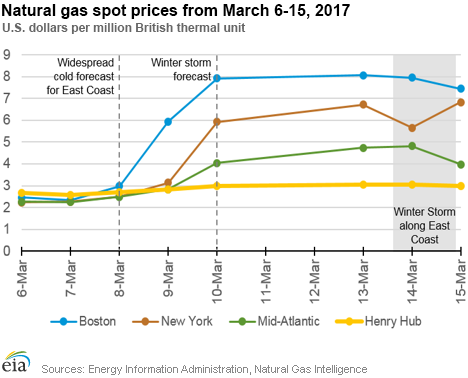
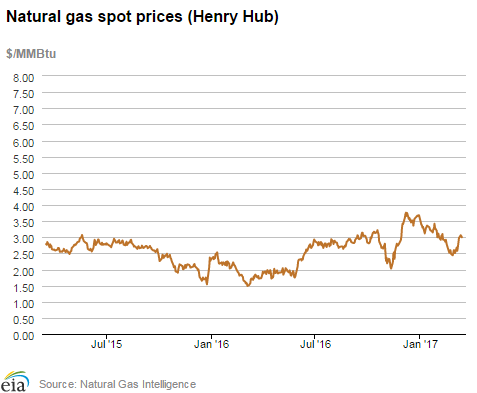
| Spot Prices ($/MMBtu) | Thu, 09-Mar |
Fri, 10-Mar |
Mon, 13-Mar |
Tue, 14-Mar |
Wed, 15-Mar |
|---|---|---|---|---|---|
| Henry Hub |
2.83 |
2.98 |
3.06 |
3.04 |
3.00 |
| New York |
3.14 |
5.93 |
6.71 |
5.66 |
6.82 |
| Chicago |
2.91 |
2.95 |
3.04 |
3.03 |
2.93 |
| Cal. Comp. Avg.* |
2.83 |
2.87 |
2.91 |
2.87 |
2.80 |
| Futures ($/MMBtu) | |||||
| April contract | 2.974 |
3.008 |
3.043 |
2.938 |
2.981 |
| May Contract |
3.046 |
3.074 |
3.107 |
2.993 |
3.040 |
| *Avg. of NGI's reported prices for: Malin, PG&E Citygate, and Southern California Border Avg. | |||||
| Source: NGI's Daily Gas Price Index | |||||
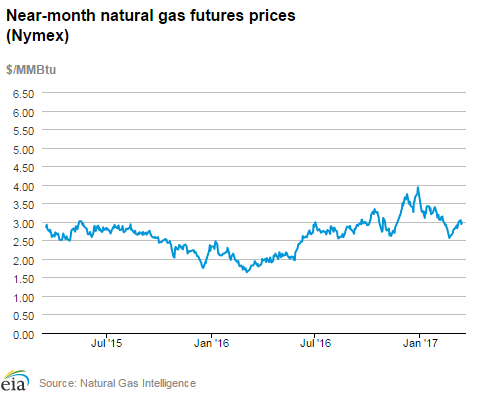
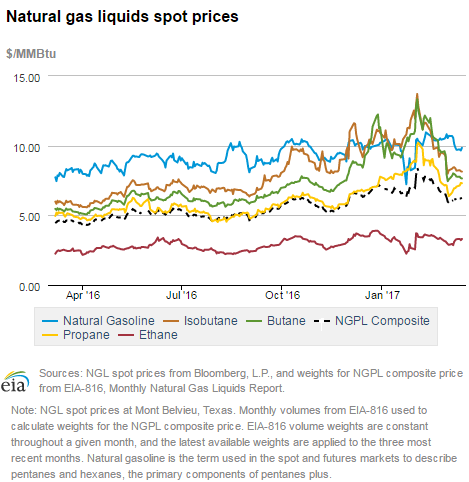
| U.S. natural gas supply - Gas Week: (3/9/17 - 3/15/17) | |||
|---|---|---|---|
Average daily values (Bcf/d): |
|||
this week |
last week |
last year |
|
| Marketed production | 79.0 |
79.1 |
81.7 |
| Dry production | 70.5 |
70.5 |
73.2 |
| Net Canada imports | 6.2 |
5.4 |
4.3 |
| LNG pipeline deliveries | 0.0 |
0.0 |
0.2 |
| Total supply | 76.7 |
75.9 |
77.7 |
|
Source: OPIS PointLogic Energy, an IHS Company | |||
| U.S. natural gas consumption - Gas Week: (3/9/17 - 3/15/17) | |||
|---|---|---|---|
Average daily values (Bcf/d): |
|||
this week |
last week |
last year |
|
| U.S. consumption | 83.7 |
73.1 |
63.7 |
| Power | 24.4 |
21.7 |
24.5 |
| Industrial | 22.6 |
21.8 |
20.7 |
| Residential/commercial | 36.7 |
29.5 |
18.5 |
| Mexico exports | 3.9 |
3.9 |
3.4 |
| Pipeline fuel use/losses | 7.4 |
6.4 |
5.6 |
| LNG pipeline receipts | 2.0 |
1.2 |
0.4 |
| Total demand | 96.9 |
84.6 |
73.2 |
|
Source: OPIS PointLogic Energy, an IHS Company | |||
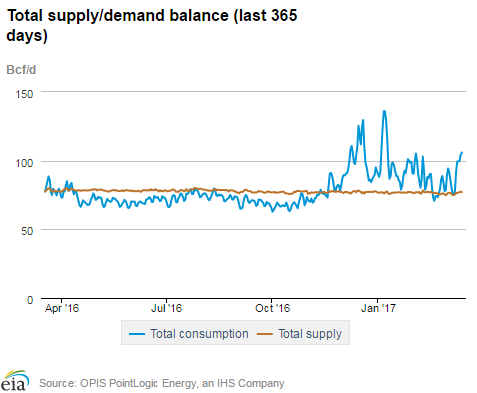
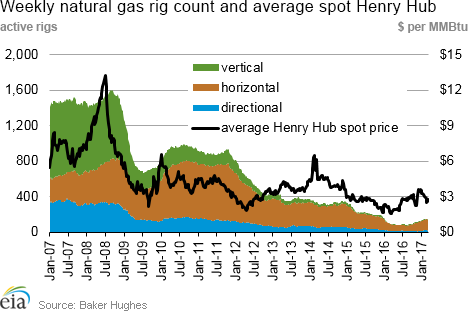
| Rigs | |||
|---|---|---|---|
Fri, March 10, 2017 |
Change from |
||
last week |
last year |
||
| Oil rigs | 617 |
1.3% |
59.8% |
| Natural gas rigs | 151 |
3.4% |
60.6% |
| Miscellaneous | 0 |
-100.0% |
0.0% |
| Rig numbers by type | |||
|---|---|---|---|
Fri, March 10, 2017 |
Change from |
||
last week |
last year |
||
| Vertical | 68 |
9.7% |
23.6% |
| Horizontal | 639 |
0.9% |
70.4% |
| Directional | 61 |
0.0% |
22.0% |
| Source: Baker Hughes Inc. | |||
| Working gas in underground storage | ||||
|---|---|---|---|---|
Stocks billion cubic feet (Bcf) |
||||
| Region | 2017-03-10 |
2017-03-03 |
change |
|
| East | 368 |
404 |
-36 |
|
| Midwest | 557 |
579 |
-22 |
|
| Mountain | 137 |
139 |
-2 |
|
| Pacific | 203 |
201 |
2 |
|
| South Central | 977 |
972 |
5 |
|
| Total | 2,242 |
2,295 |
-53 |
|
| Source: U.S. Energy Information Administration | ||||
| Working gas in underground storage | |||||
|---|---|---|---|---|---|
Historical comparisons |
|||||
Year ago (3/10/16) |
5-year average (2012-2016) |
||||
| Region | Stocks (Bcf) |
% change |
Stocks (Bcf) |
% change |
|
| East | 454 |
-18.9 |
367 |
0.3 |
|
| Midwest | 578 |
-3.6 |
411 |
35.5 |
|
| Mountain | 147 |
-6.8 |
124 |
10.5 |
|
| Pacific | 259 |
-21.6 |
225 |
-9.8 |
|
| South Central | 1,040 |
-6.1 |
721 |
35.5 |
|
| Total | 2,478 |
-9.5 |
1,847 |
21.4 |
|
| Source: U.S. Energy Information Administration | |||||
| Temperature – heating & cooling degree days (week ending Mar 09) | ||||||||
|---|---|---|---|---|---|---|---|---|
HDD deviation from: |
CDD deviation from: |
|||||||
| Region | HDD Current |
normal |
last year |
CDD Current |
normal |
last year |
||
| New England | 236 |
13 |
13 |
0 |
0 |
0 |
||
| Middle Atlantic | 203 |
-6 |
4 |
0 |
0 |
0 |
||
| E N Central | 177 |
-44 |
-26 |
0 |
-1 |
0 |
||
| W N Central | 161 |
-60 |
2 |
0 |
-1 |
0 |
||
| South Atlantic | 115 |
-13 |
-14 |
10 |
0 |
1 |
||
| E S Central | 92 |
-30 |
-28 |
0 |
-3 |
0 |
||
| W S Central | 43 |
-34 |
5 |
16 |
7 |
3 |
||
| Mountain | 144 |
-27 |
29 |
1 |
0 |
-3 |
||
| Pacific | 100 |
6 |
22 |
0 |
-1 |
0 |
||
| United States | 142 |
-23 |
-1 |
4 |
1 |
0 |
||
|
Note: HDD = heating degree day; CDD = cooling degree day Source: National Oceanic and Atmospheric Administration | ||||||||
Average temperature (°F)
7-Day Mean ending Mar 09, 2017
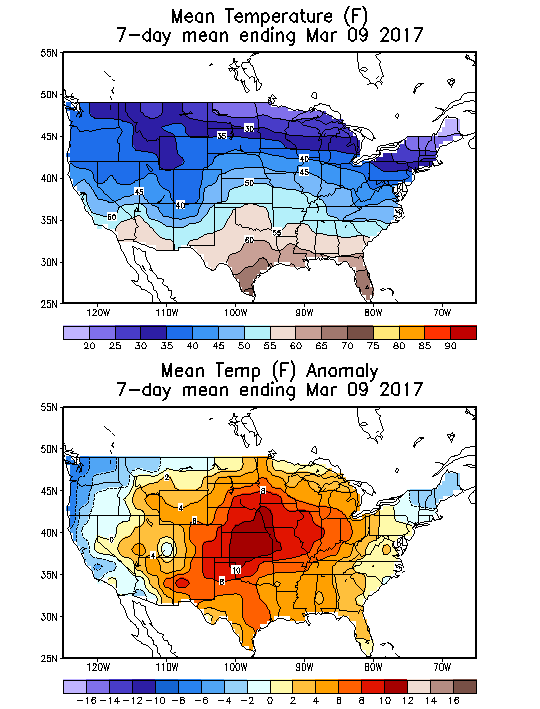
Source: NOAA National Weather Service
Deviation between average and normal (°F)
7-Day Mean ending Mar 09, 2017

Source: NOAA National Weather Service

